
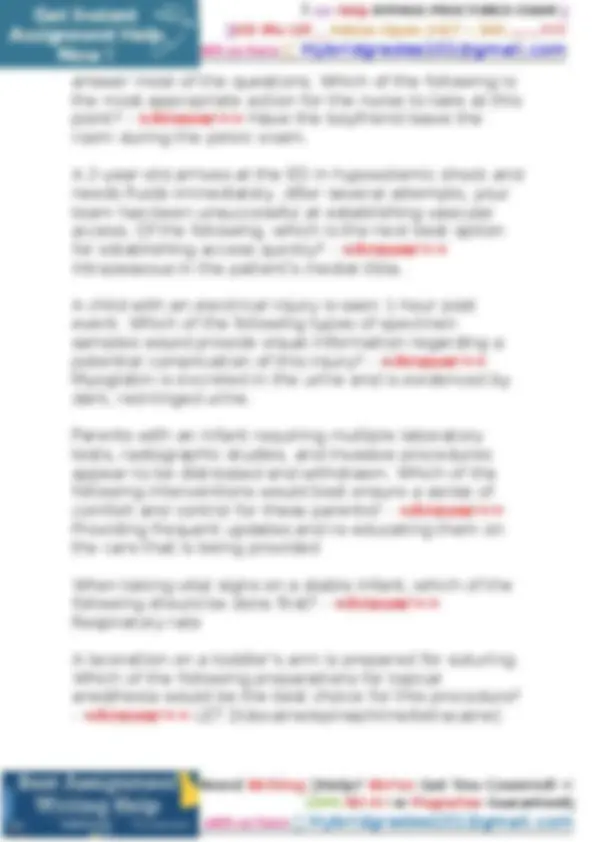
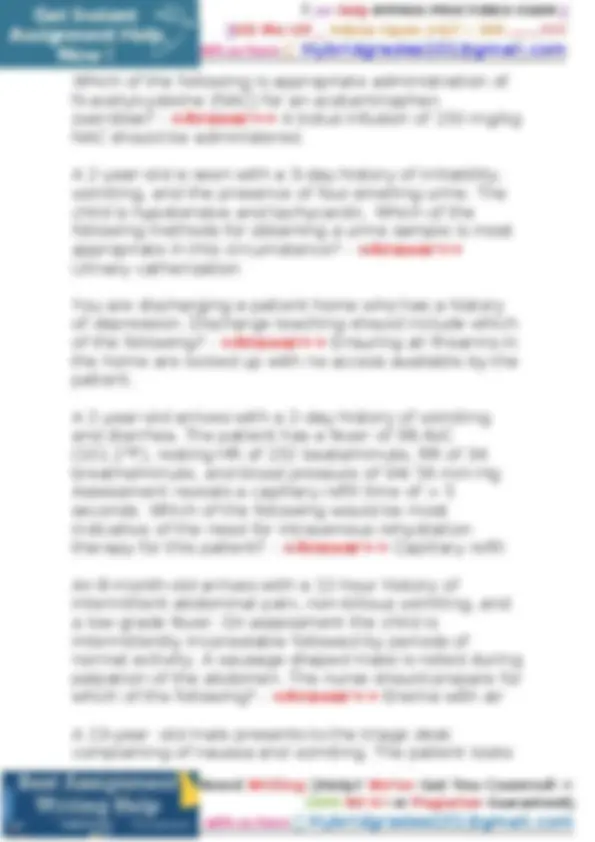
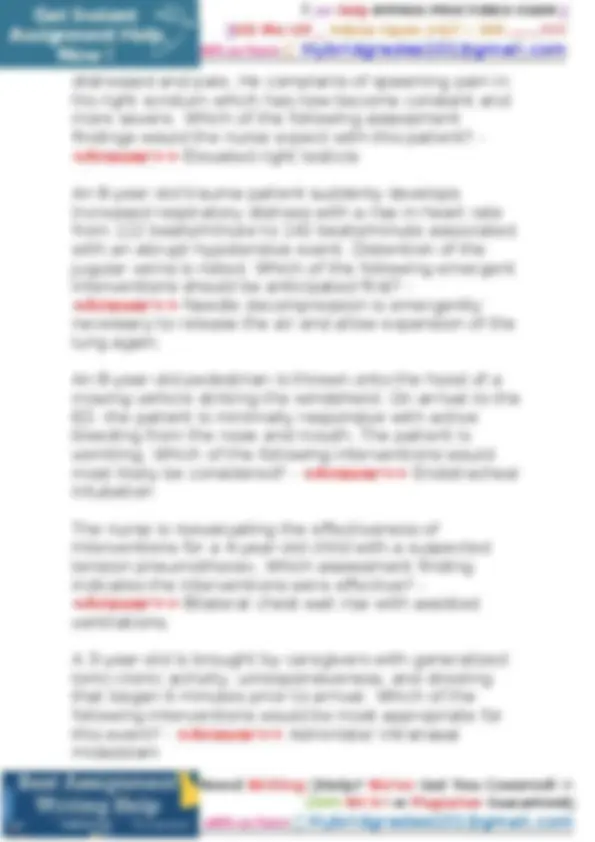
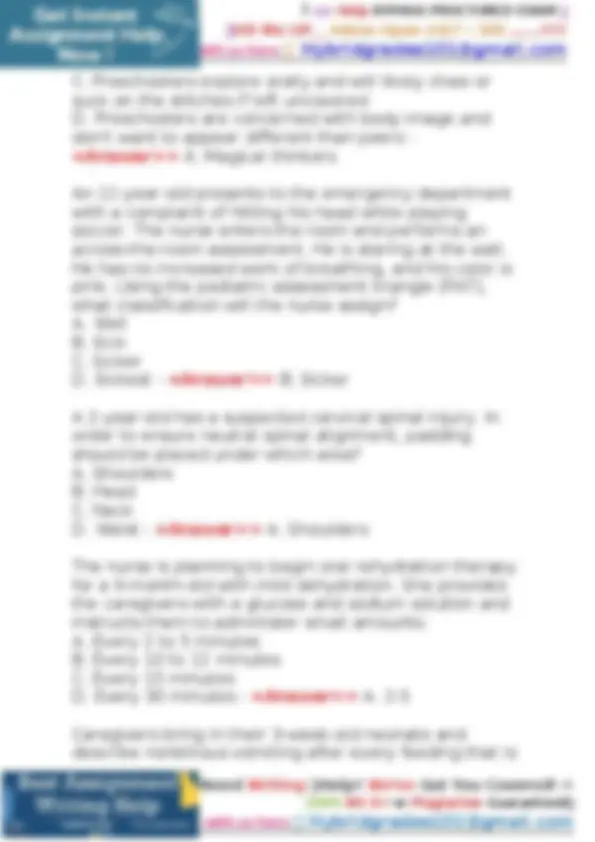
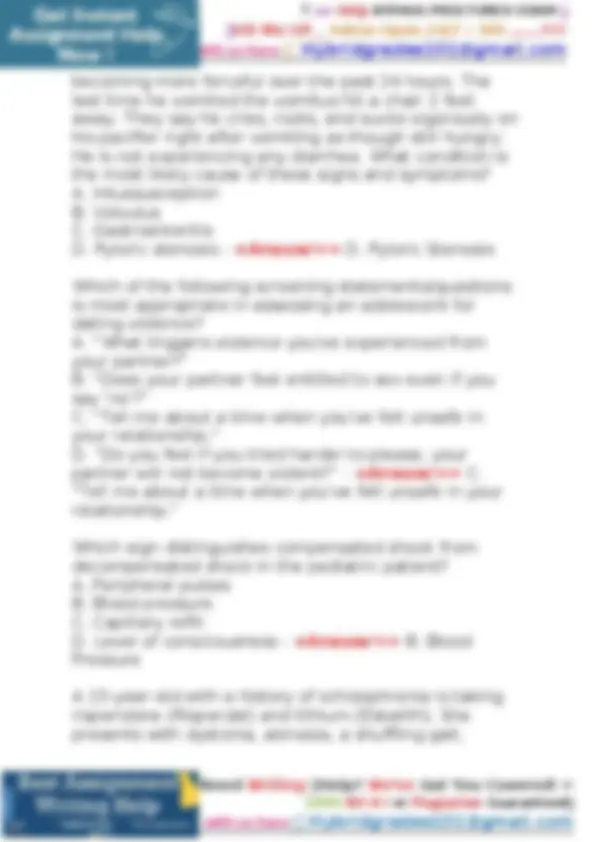
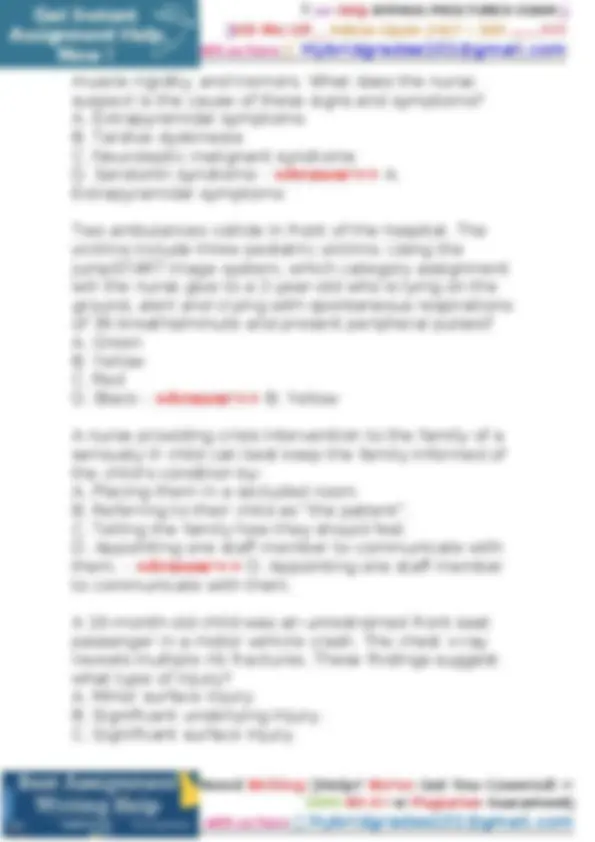
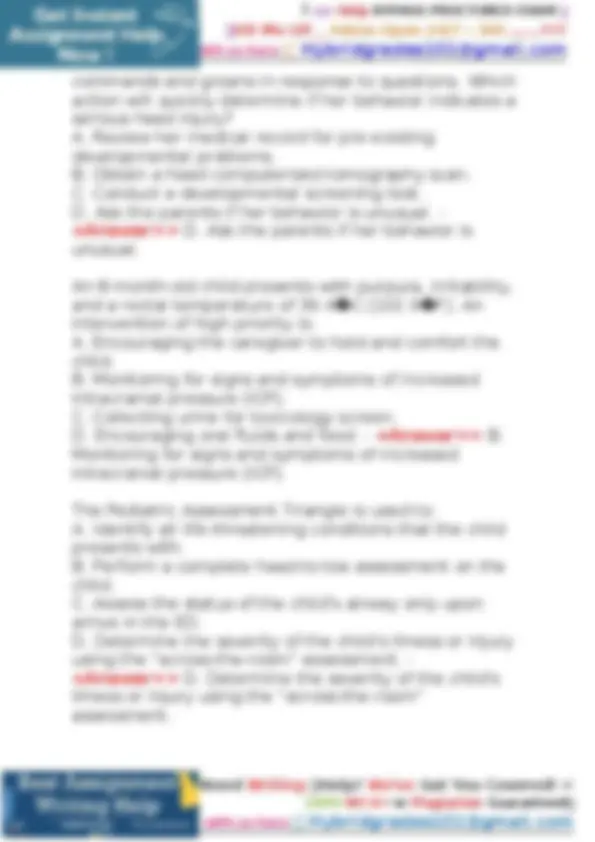
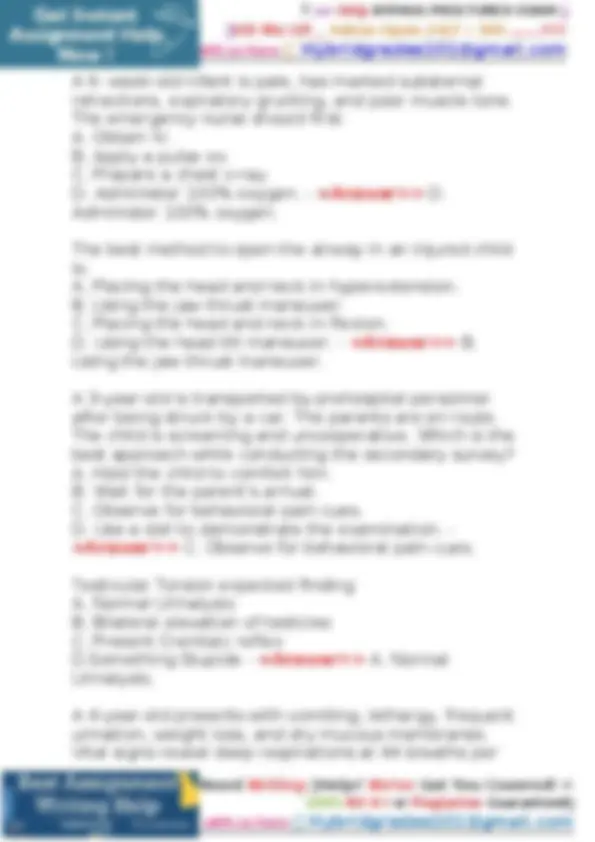
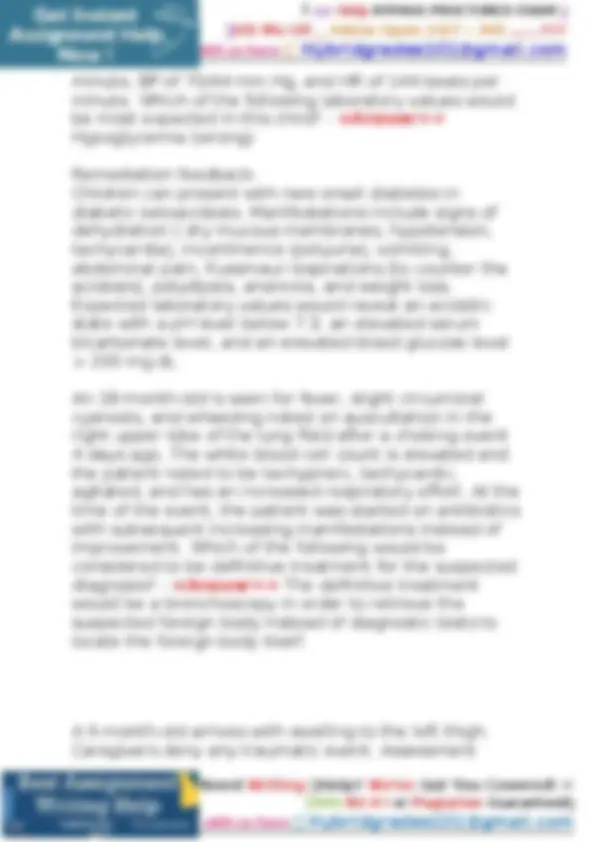
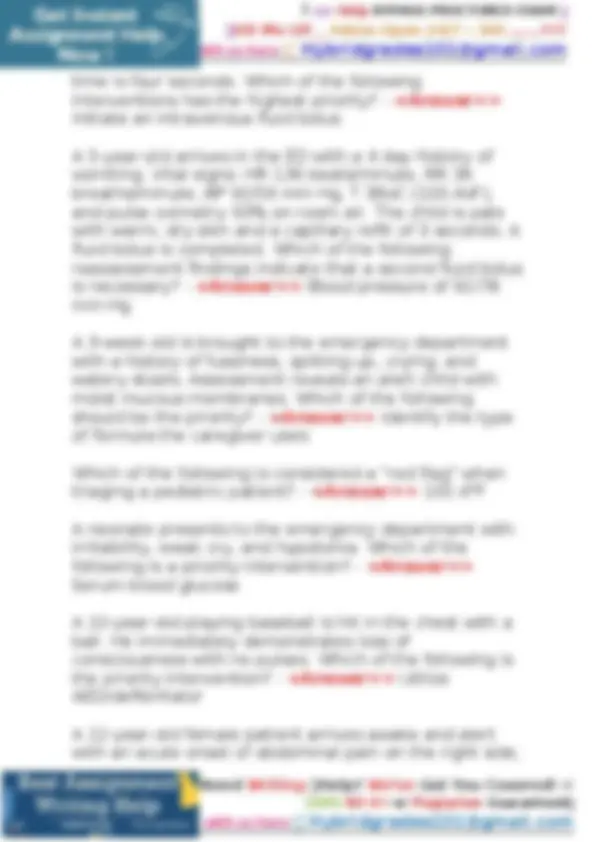
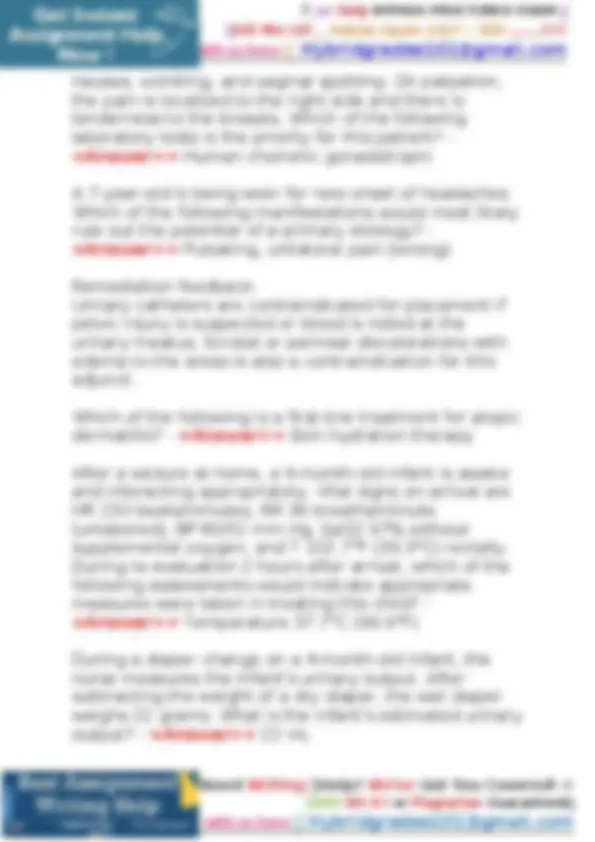
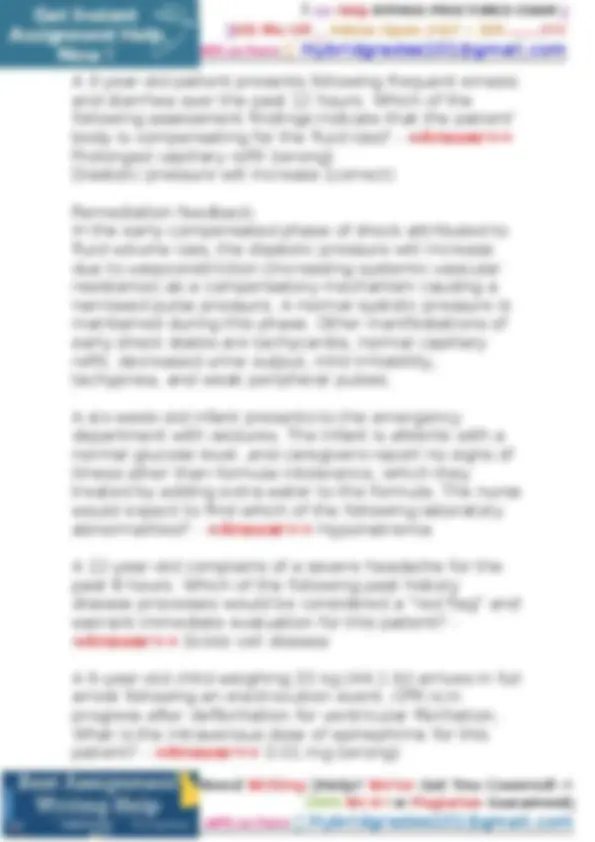
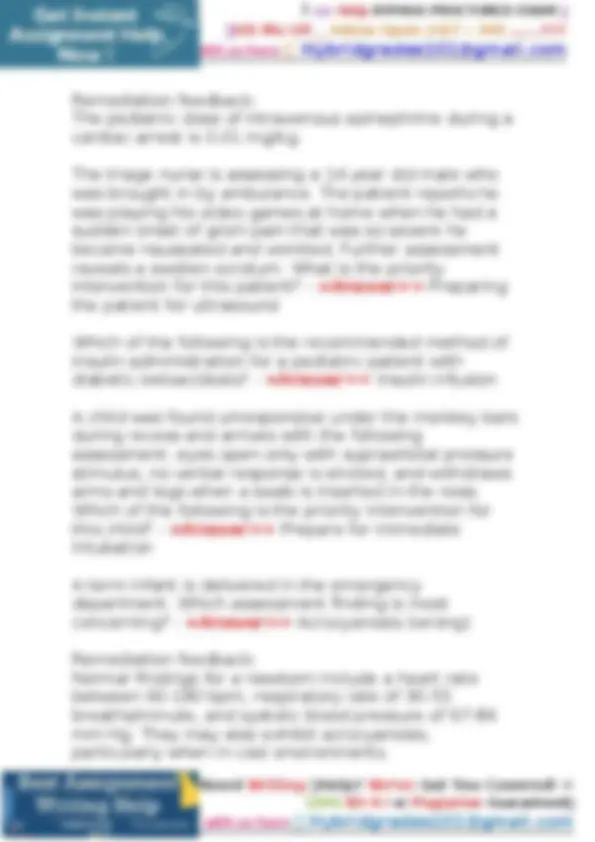
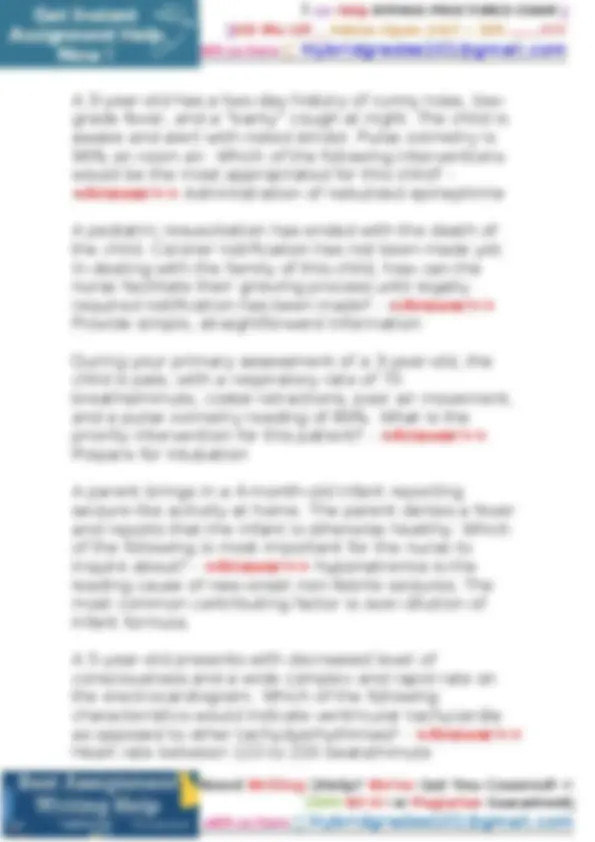
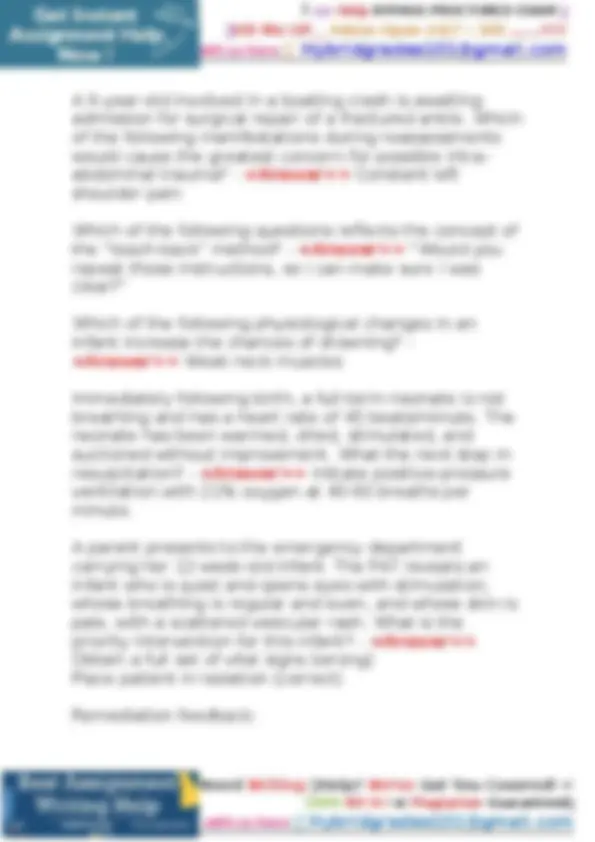
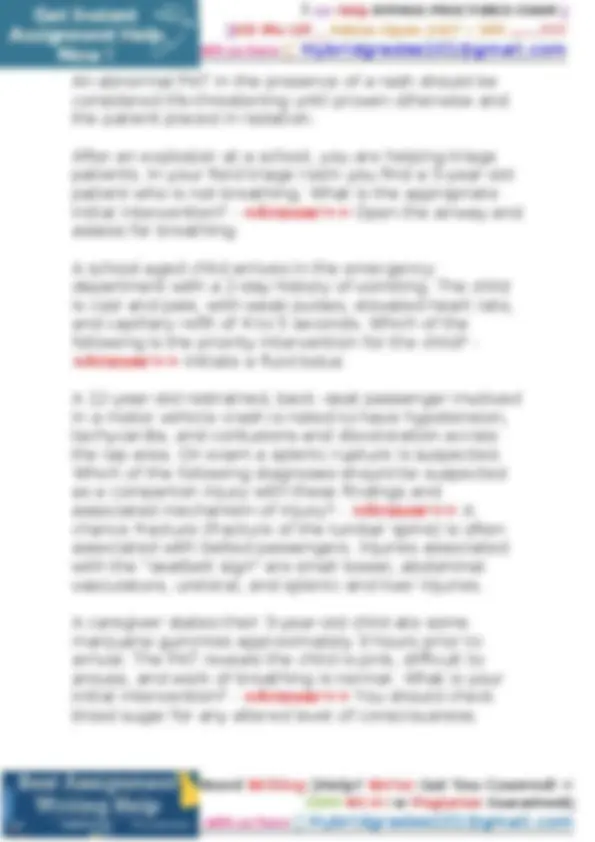
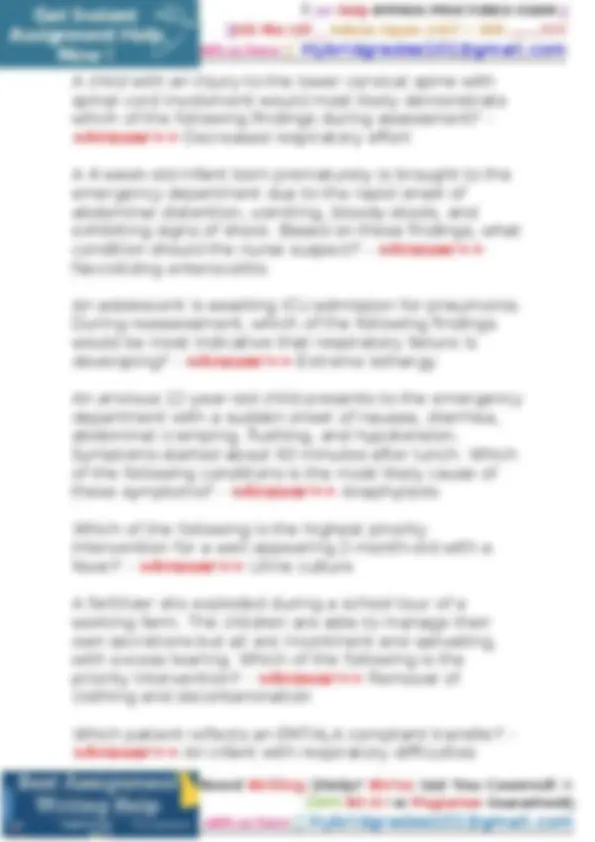
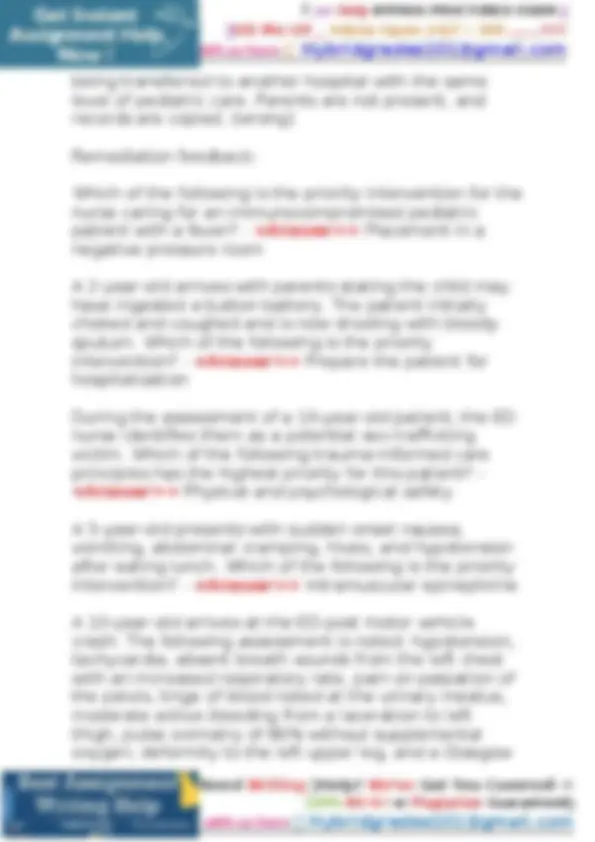
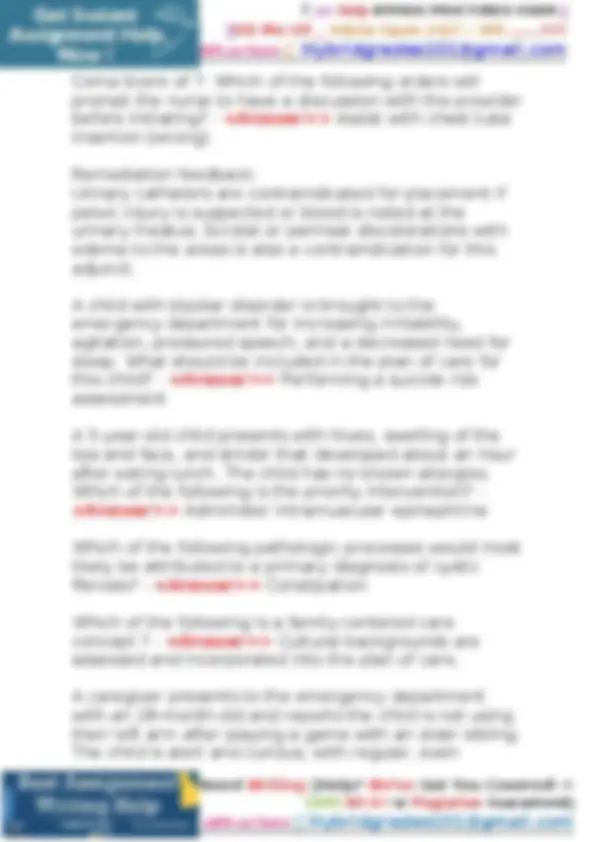
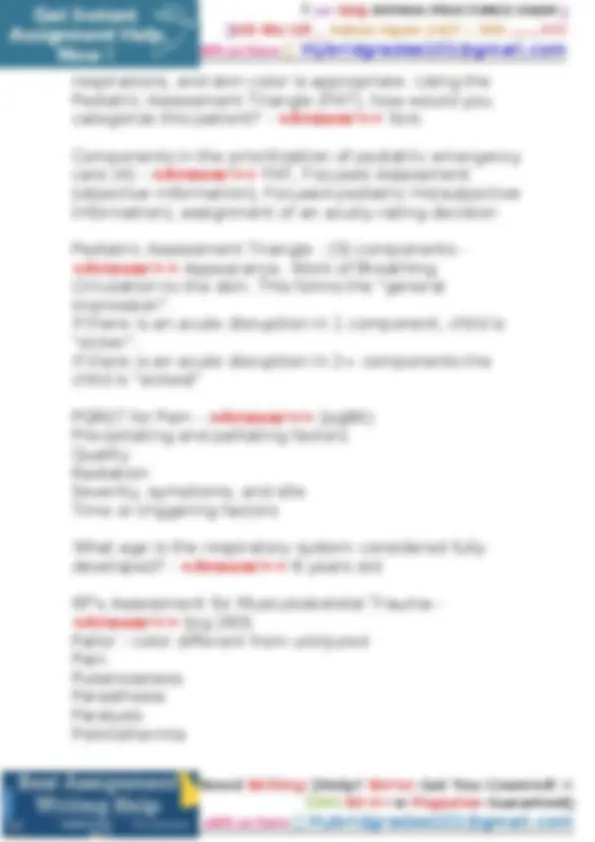
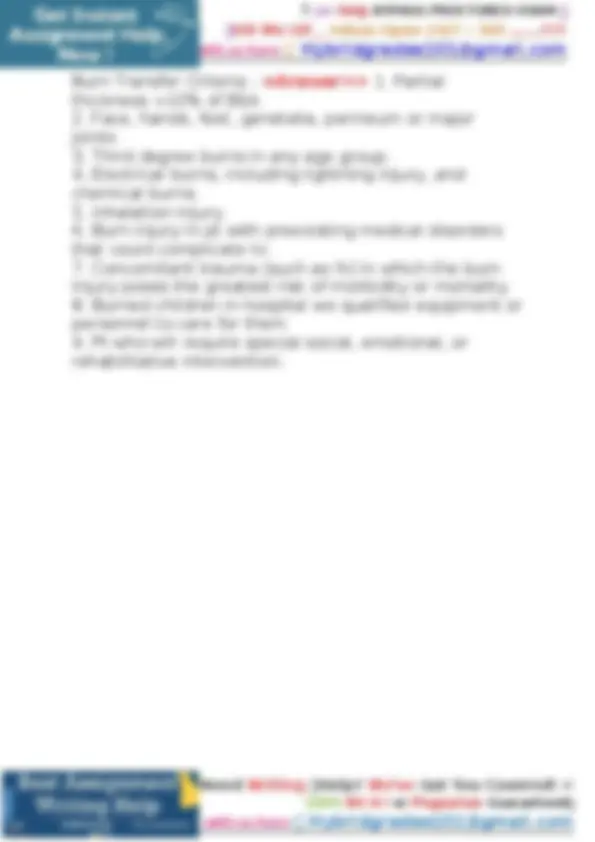


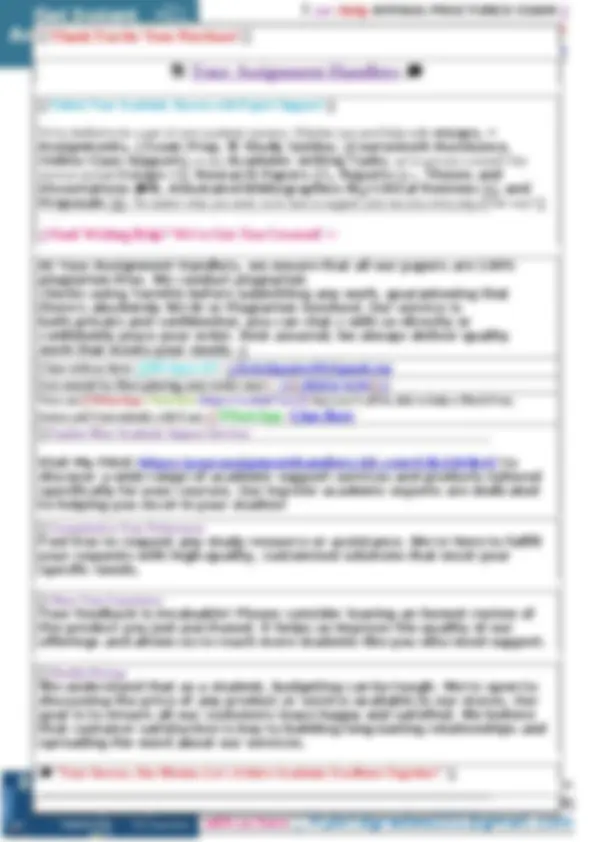



Study with the several resources on Docsity

Earn points by helping other students or get them with a premium plan


Prepare for your exams
Study with the several resources on Docsity

Earn points to download
Earn points by helping other students or get them with a premium plan
Community
Ask the community for help and clear up your study doubts
Discover the best universities in your country according to Docsity users
Free resources
Download our free guides on studying techniques, anxiety management strategies, and thesis advice from Docsity tutors
A comprehensive review of the enpc emergency nursing pediatric course certification exam. It includes multiple-choice questions and answers covering various topics related to pediatric emergency care, such as assessment, management, and interventions for common pediatric emergencies. Designed to help students prepare for the enpc certification exam and enhance their understanding of pediatric emergency nursing principles.
Typology: Exams
1 / 33

This page cannot be seen from the preview
Don't miss anything!


























Course Title and Number: ATLS Written Examination & Practical Skills Assessment Exam Title: ATLS Exam Exam Date: Exam 2025- 2026 Instructor: ____ [Insert Instructor’s Name] _______ Student Name: ___ [Insert Student’s Name] _____ Student ID: ____ [Insert Student ID] _____________
Time: - ____ Hours: ___ Minutes
**1. Read each question carefully.
📱Hit Me UP__ Inbox Open 24/7 – 365 …...!!!! 📱 Chat with us here: 📱 Hybridgrades101@gmail.com
Read All Instructions Carefully and Answer All the Questions Correctly Good Luck: - A 12-year-old is being prepped for surgical intervention of acute appendicitis. Which of the following intravenous medication orders should the nurse question? - =Answer>> Ketorolac Remediation feedback: Ketorolac is an appropriate medication for moderate to severe pain, however, it should not be used pre- operatively due to its potential to increase the bleeding risk. A 17-year-old female arrives in the ED with her boyfriend who states she is pregnant and having vaginal bleeding. The patient is unsure of the gestational age and has not had any prenatal treatment. The patient is quiet and lets her boyfriend Need Writing 📱Help? We've Got You Covered! ✍ 100% NO A I or Plagiarism Guaranteed📱 Click Here To <
NOW.!!!
📱Hit Me UP__ Inbox Open 24/7 – 365 …...!!!! 📱 Chat with us here: 📱 Hybridgrades101@gmail.com Which of the following is appropriate administration of N-acetylcysteine (NAC) for an acetaminophen overdose? - =Answer>> A bolus infusion of 150 mg/kg NAC should be administered. A 2-year-old is seen with a 3-day history of irritability, vomiting, and the presence of foul-smelling urine. The child is hypotensive and tachycardic. Which of the following methods for obtaining a urine sample is most appropriate in this circumstance? - =Answer>> Urinary catherization You are discharging a patient home who has a history of depression. Discharge teaching should include which of the following? - =Answer>> Ensuring all firearms in the home are locked up with no access available by the patient. A 2-year-old arrives with a 2-day history of vomiting and diarrhea. The patient has a fever of 38.4oC (101.2°F), resting HR of 152 beats/minute, RR of 34 breaths/minute, and blood pressure of 94/ 56 mm Hg. Assessment reveals a capillary refill time of > 5 seconds. Which of the following would be most indicative of the need for intravenous rehydration therapy for this patient? - =Answer>> Capillary refill An 8-month-old arrives with a 12-hour history of intermittent abdominal pain, non-bilious vomiting, and a low grade fever. On assessment the child is intermittently inconsolable followed by periods of normal activity. A sausage-shaped mass is noted during palpation of the abdomen. The nurse should prepare for which of the following? - =Answer>> Enema with air A 13-year -old male presents to the triage desk complaining of nausea and vomiting. The patient looks Need Writing 📱Help? We've Got You Covered! ✍ 100% NO A I or Plagiarism Guaranteed📱
📱Hit Me UP__ Inbox Open 24/7 – 365 …...!!!! 📱 Chat with us here: 📱 Hybridgrades101@gmail.com distressed and pale. He complains of spasming pain in his right scrotum which has now become constant and more severe. Which of the following assessment findings would the nurse expect with this patient? - =Answer>> Elevated right testicle An 8-year-old trauma patient suddenly develops increased respiratory distress with a rise in heart rate from 112 beats/minute to 142 beats/minute associated with an abrupt hypotensive event. Distention of the jugular veins is noted. Which of the following emergent interventions should be anticipated first? - =Answer>> Needle decompression is emergently necessary to release the air and allow expansion of the lung again. An 8-year-old pedestrian is thrown onto the hood of a moving vehicle striking the windshield. On arrival to the ED. the patient is minimally responsive with active bleeding from the nose and mouth. The patient is vomiting. Which of the following interventions would most likely be considered? - =Answer>> Endotracheal intubation The nurse is reevaluating the effectiveness of interventions for a 4-year-old child with a suspected tension pneumothorax. Which assessment finding indicates the interventions were effective? - =Answer>> Bilateral chest wall rise with assisted ventilations. A 3-year-old is brought by caregivers with generalized tonic-clonic activity, unresponsiveness, and drooling that began 6 minutes prior to arrival. Which of the following interventions would be most appropriate for this event? - =Answer>> Administer intranasal midazolam Need Writing 📱Help? We've Got You Covered! ✍ 100% NO A I or Plagiarism Guaranteed📱
📱Hit Me UP__ Inbox Open 24/7 – 365 …...!!!! 📱 Chat with us here: 📱 Hybridgrades101@gmail.com Petiachia/Purpura Normal Urine Output for child - =Answer>> 1 to 2ml / Kg / Hr Oral Rehydration for 9month old with mild dehydration.
📱Hit Me UP__ Inbox Open 24/7 – 365 …...!!!! 📱 Chat with us here: 📱 Hybridgrades101@gmail.com C. Preschoolers explore orally and will likely chew or suck on the stitches if left uncovered D. Preschoolers are concerned with body image and don't want to appear different than peers - =Answer>> A. Magical thinkers An 11-year-old presents to the emergency department with a complaint of hitting his head while playing soccer. The nurse enters the room and performs an across-the-room assessment. He is staring at the wall. He has no increased work of breathing, and his color is pink. Using the pediatric assessment triangle (PAT), what classification will the nurse assign? A. Well B. Sick C. Sicker D. Sickest - =Answer>> B. Sicker A 2-year-old has a suspected cervical spinal injury. In order to ensure neutral spinal alignment, padding should be placed under which area? A. Shoulders B. Head C. Neck D. Waist - =Answer>> A. Shoulders The nurse is planning to begin oral rehydration therapy for a 9-month-old with mild dehydration. She provides the caregivers with a glucose and sodium solution and instructs them to administer small amounts: A. Every 2 to 5 minutes B. Every 10 to 12 minutes C. Every 15 minutes D. Every 30 minutes - =Answer>> A. 2- Caregivers bring in their 3-week-old neonate and describe nonbilious vomiting after every feeding that is Need Writing 📱Help? We've Got You Covered! ✍ 100% NO A I or Plagiarism Guaranteed📱
📱Hit Me UP__ Inbox Open 24/7 – 365 …...!!!! 📱 Chat with us here: 📱 Hybridgrades101@gmail.com muscle rigidity, and tremors. What does the nurse suspect is the cause of these signs and symptoms? A. Extrapyramidal symptoms B. Tardive dyskinesia C. Neuroleptic malignant syndrome D. Serotonin syndrome - =Answer>> A. Extrapyramidal symptoms Two ambulances collide in front of the hospital. The victims include three pediatric victims. Using the JumpSTART triage system, which category assignment will the nurse give to a 2-year-old who is lying on the ground, alert and crying with spontaneous respirations of 36 breaths/minute and present peripheral pulses? A. Green B. Yellow C. Red D. Black - =Answer>> B. Yellow A nurse providing crisis intervention to the family of a seriously ill child can best keep the family informed of the child's condition by: A. Placing them in a secluded room. B. Referring to their child as "the patient". C. Telling the family how they should feel. D. Appointing one staff member to communicate with them. - =Answer>> D. Appointing one staff member to communicate with them. A 16-month-old child was an unrestrained front seat passenger in a motor vehicle crash. The chest x-ray reveals multiple rib fractures. These findings suggest what type of injury? A. Minor surface injury. B. Significant underlying injury. C. Significant surface injury. Need Writing 📱Help? We've Got You Covered! ✍ 100% NO A I or Plagiarism Guaranteed📱
📱Hit Me UP__ Inbox Open 24/7 – 365 …...!!!! 📱 Chat with us here: 📱 Hybridgrades101@gmail.com D. Minor underlying injury. - =Answer>> B. Significant underlying injury. Which piece of information is most important to know prior to transferring a patient to another facility? A. Documentation of the family's health insurance coverage. B. Pertinent family health history. C. Confirmation of acceptance from the receiving hospital. D. Confirmation of a medical diagnosis. - =Answer>> C. Confirmation of acceptance from the receiving hospital. A 10-year-old child who was struck by a car has a distended, tense abdomen. The child's heart rate is 144 beats/minute, respirations 24 breaths/minute, and blood pressure 120/80 mm Hg. Capillary refill is more than 3 seconds, and skin is pale and cool. The patient's signs and symptoms suggest: A. Obstructive shock. B. Distributive shock. C. Hypovolemic shock. D. Cardiogenic shock. - =Answer>> C. Hypovolemic shock. What is the preferred sit for intraosseous access in the infant? A. Lateral malleolus B. Iliac crest C. Proximal femur D. Proximal tibia - =Answer>> D. Proximal tibia An 8-month-old infant with pneumonia has severe intercostal and substernal retractions, weak muscle tone, lethargy, and gray skin color. The infant's Need Writing 📱Help? We've Got You Covered! ✍ 100% NO A I or Plagiarism Guaranteed📱
📱Hit Me UP__ Inbox Open 24/7 – 365 …...!!!! 📱 Chat with us here: 📱 Hybridgrades101@gmail.com commands and groans in response to questions. Which action will quickly determine if her behavior indicates a serious head injury? A. Review her medical record for pre-existing developmental problems. B. Obtain a head computerized tomography scan. C. Conduct a developmental screening test. D. Ask the parents if her behavior is unusual. - =Answer>> D. Ask the parents if her behavior is unusual. An 8-month-old child presents with purpura, irritability, and a rectal temperature of 39.4�C (102.9�F). An intervention of high priority is: A. Encouraging the caregiver to hold and comfort the child. B. Monitoring for signs and symptoms of increased intracranial pressure (ICP). C. Collecting urine for toxicology screen. D. Encouraging oral fluids and food. - =Answer>> B. Monitoring for signs and symptoms of increased intracranial pressure (ICP). The Pediatric Assessment Triangle is used to: A. Identify all life-threatening conditions that the child presents with. B. Perform a complete head-to-toe assessment on the child. C. Assess the status of the child's airway only upon arrive in the ED. D. Determine the severity of the child's illness or injury using the "across-the-room" assessment. - =Answer>> D. Determine the severity of the child's illness or injury using the "across-the-room" assessment. Need Writing 📱Help? We've Got You Covered! ✍ 100% NO A I or Plagiarism Guaranteed📱
📱Hit Me UP__ Inbox Open 24/7 – 365 …...!!!! 📱 Chat with us here: 📱 Hybridgrades101@gmail.com A 6- week-old infant is pale, has marked substernal retractions, expiratory grunting, and poor muscle tone. The emergency nurse should first: A. Obtain IV. B. Apply a pulse ox. C. Prepare a chest x-ray. D. Administer 100% oxygen. - =Answer>> D. Administer 100% oxygen. The best method to open the airway in an injured child is: A. Placing the head and neck in hyperextension. B. Using the jaw thrust maneuver. C. Placing the head and neck in flexion. D. Using the head tilt maneuver. - =Answer>> B. Using the jaw thrust maneuver. A 3-year-old is transported by prehospital personnel after being struck by a car. The parents are en route. The child is screaming and uncooperative. Which is the best approach while conducting the secondary survey? A. Hold the child to comfort him. B. Wait for the parent's arrival. C. Observe for behavioral pain cues. D. Use a doll to demonstrate the examination. - =Answer>> C. Observe for behavioral pain cues. Testicular Torsion expected finding A. Normal Urinalysis B. Bilateral elevation of testicles C. Present Cremtaic reflex D.Something Stupide - =Answer>> A. Normal Urinalysis. A 4-year-old presents with vomiting, lethargy, frequent urination, weight loss, and dry mucous membranes. Vital signs reveal deep respirations at 44 breaths per Need Writing 📱Help? We've Got You Covered! ✍ 100% NO A I or Plagiarism Guaranteed📱
📱Hit Me UP__ Inbox Open 24/7 – 365 …...!!!! 📱 Chat with us here: 📱 Hybridgrades101@gmail.com findings include a patient who is active and alert, in the 10th percentile for length, and has blue-grey sclera. Radiographs reveal a midshaft fracture of the left femur. Which of the following is the most likely cause? - =Answer>> Osteogenesis imperfecta A 14-year-old patient had a reduction of a temporomandibular joint dislocation in the ED. Which of the following should be included in the discharge instructions? - =Answer>> Cold or warm, not hot, compresses are recommended along with nonsteroidal anti-inflammatory medications for pain control. A 5-year-old patient presents with severe dehydration and signs of shock due to viral gastroenteritis. Which of the following physiologic responses by this patient will have the greatest impact on improving their cardiac output? - =Answer>> Increased heart rate An 8-year-old male presents to the emergency department with incoherent speech, hallucinations, and violent behavior. What is the priority in caring for this patient? - =Answer>> Ensure safety of the patient and staff A 12-year-old presents to the emergency department with a severe headache. The mother reports that the child has been experiencing headaches and has had multiple seizures for the past several months. The child was seen by their primary doctor and prescribed an anti-seizure medication, but the prescription was not filled because "the doctor just wants money." This is an example of what type of neglect? - =Answer>> Medical A 14-year-old patient with Down syndrome presents with an abnormal gait, head tilted to the left, decreased Need Writing 📱Help? We've Got You Covered! ✍ 100% NO A I or Plagiarism Guaranteed📱
📱Hit Me UP__ Inbox Open 24/7 – 365 …...!!!! 📱 Chat with us here: 📱 Hybridgrades101@gmail.com sensation to the extremities, and urinary incontinence. The patient has no history of trauma. Which of the following diagnostics is the priority for this patient? - =Answer>> Cervical spine radiographs The nurse is triaging an infant brought to the emergency department by their caregiver. Which finding by the nurse leads the infant to be placed in isolation? - =Answer>> The presence of a purpuric rash necessitates the infant to be placed in isolation immediately as this is a symptom of possible meningitis. EMS is transporting a 12-year-old restrained passenger involved in a high-speed motor vehicle collision. The patient complains of increasing dyspnea. Breath sounds are clear and equal, and heart sounds are difficult to auscultate. Vitals include HR 132 beats/minute, RR 36 breaths/minute, and BP 80/55 mm Hg. Which of the following is the priority intervention? - =Answer>> Pericardiocentesis A 3-year-old is assessed for the presence of increasing amounts of serosanguineous drainage from his left nares over the past 6 hours. Which of the following foreign bodies is the most likely etiology? - =Answer>> Button battery An infant presents to the emergency department with difficulty breathing. The patient is pale and respirations appear rapid and shallow. Which location on the torso is the most effective site for assessing bilateral breath sounds? - =Answer>> Bilateral midaxillary A child presents with a history of poor oral intake. The patient is pale, lethargic, and has shallow, rapid respirations. Central pulses are weak and capillary refill Need Writing 📱Help? We've Got You Covered! ✍ 100% NO A I or Plagiarism Guaranteed📱
📱Hit Me UP__ Inbox Open 24/7 – 365 …...!!!! 📱 Chat with us here: 📱 Hybridgrades101@gmail.com nausea, vomiting, and vaginal spotting. On palpation, the pain is localized to the right side and there is tenderness to the breasts. Which of the following laboratory tests is the priority for this patient? - =Answer>> Human chorionic gonadotropin A 7-year-old is being seen for new onset of headaches. Which of the following manifestations would most likely rule out the potential of a primary etiology? - =Answer>> Pulsating, unilateral pain (wrong) Remediation feedback: Urinary catheters are contraindicated for placement if pelvic injury is suspected or blood is noted at the urinary meatus. Scrotal or perineal discolorations with edema to the areas is also a contraindication for this adjunct. Which of the following is a first-line treatment for atopic dermatitis? - =Answer>> Skin hydration therapy After a seizure at home, a 9-month-old infant is awake and interacting appropriately. Vital signs on arrival are HR 150 beats/minutes, RR 36 breaths/minute (unlabored), BP 80/52 mm Hg, SaO2 97% without supplemental oxygen, and T 102.7°F (39.3°C) rectally. During re-evaluation 2 hours after arrival, which of the following assessments would indicate appropriate measures were taken in treating this child? - =Answer>> Temperature 37.7°C (99.9°F) During a diaper change on a 4-month-old infant, the nurse measures the infant's urinary output. After subtracting the weight of a dry diaper, the wet diaper weighs 22 grams. What is the infant's estimated urinary output? - =Answer>> 22 mL Need Writing 📱Help? We've Got You Covered! ✍ 100% NO A I or Plagiarism Guaranteed📱
📱Hit Me UP__ Inbox Open 24/7 – 365 …...!!!! 📱 Chat with us here: 📱 Hybridgrades101@gmail.com A 3 year-old patient presents following frequent emesis and diarrhea over the past 12 hours. Which of the following assessment findings indicate that the patient' body is compensating for the fluid loss? - =Answer>> Prolonged capillary refill (wrong) Diastolic pressure will increase (correct) Remediation feedback: In the early compensated phase of shock attributed to fluid volume loss, the diastolic pressure will increase due to vasoconstriction (increasing systemic vascular resistance) as a compensatory mechanism causing a narrowed pulse pressure. A normal systolic pressure is maintained during this phase. Other manifestations of early shock states are tachycardia, normal capillary refill, decreased urine output, mild irritability, tachypnea, and weak peripheral pulses. A six-week-old infant presents to the emergency department with seizures. The infant is afebrile with a normal glucose level ,and caregivers report no signs of illness other than formula intolerance, which they treated by adding extra water to the formula. The nurse would expect to find which of the following laboratory abnormalities? - =Answer>> Hyponatremia A 12-year-old complains of a severe headache for the past 8 hours. Which of the following past history disease processes would be considered a "red flag" and warrant immediate evaluation for this patient? - =Answer>> Sickle cell disease A 6-year-old child weighing 20 kg (44.1 lb) arrives in full arrest following an electrocution event. CPR is in progress after defibrillation for ventricular fibrillation. What is the intravenous dose of epinephrine for this patient? - =Answer>> 0.01 mg (wrong) Need Writing 📱Help? We've Got You Covered! ✍ 100% NO A I or Plagiarism Guaranteed📱